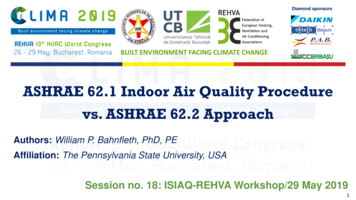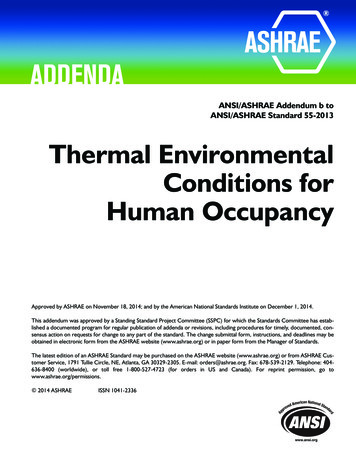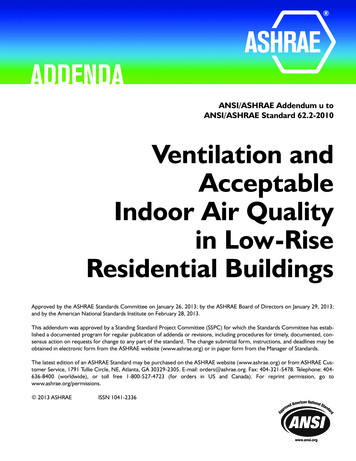
Transcription
Energy EfficientKitchen Ventilation DesignTyler SchillingGreenheck Fan Corporation1
Learning Objectives Kitchen design objectives Kitchen control technology DCV application and design2
Design Objectives Comply with local and industry codes– IMC Section 507 – Commercial Kitchen Hoods– NFPA 96 - Standard for Ventilation Control and FireProtection of Commercial Cooking Operations– ASHRAE 90.1 - Energy Standard for Buildings Minimize cost3
IMC Section 507Commercial Kitchen Hoods507.1 General.Commercial kitchen exhaust hoods shall comply with therequirements of this section. Hoods shall be Type I or Type IIand shall be designed to capture and confine cooking vaporsand residues.Exception:1. Factory-built commercial exhaust hoods which are tested inaccordance with UL 710, listed, labeled and installed inaccordance with Section 304.1 shall not be required tocomply with Sections 507.4, 507.7, 507.11, 507.12, 507.13,507.14 and 507.15.4
Scope of UL 7101.1 These requirements cover exhaust hoodsintended for placement over commercialcooking equipment. Exhaust hoods with andwithout exhaust dampers are covered bythese requirements.1.3 All exhaust hoods are intended for use withfire extinguishing system units.55
IMC Section 507Commercial Kitchen Hoods Factory-build kitchen exhaust hoods which are tested inaccordance with UL 710.shall not be required to comply withSections507.4 - Type I materials507.7 - Hood joints, seams and penetrations507.11 - Grease filters507.12 - Canopy size and location507.13 - Capacity of hoods507.14 – Non-canopy size and location507.15 - Exhaust outlets6
Capacity of Hoods 507.13*Commercial food service hoods shall exhaust a minimum net air inaccordance with this section and section 507.13.1 through507.13.4. The net quantity of exhaust air shall be calculated bysubtracting any airflow supplied directly to a hood cavity from thetotal flow rate of a hood.Where any combination of heavy-duty, medium-duty and light-dutycooking appliances are utilized under a single hood, the exhaustrate required by this section for the heaviest duty appliance coveredby the hood shall be used for the entire hood.77
Calculation Using IMCCFM (Exhaust Rate) (Linear Foot of Hood)Exhaust rates:Light-duty200 cfm/ln. ft (Ovens, steamers, kettles)Medium-duty300 cfm/ln. ft (Electric ranges, griddles, fryers)Heavy-duty400 cfm/ln. ft (Gas ranges, broilers, woks)Extra heavy-duty 550 cfm/ln. ft (Solid fuel cooking)“The above are for wall canopy hoods”8
Calculation Using IMCChar-broiler Heavy-duty (400 cfm per linear foot)400 cfm/ln. ft x 8 ft 3,200 cfm9
Alternate Calculation ExampleManufacturer Method10
Exhaust Air Volume Total required exhaustmust equal contaminatedairflow plus a minimumcapture airflowQC Contaminated air generated by the cooking equipmentQF Quantity of air to contain surges, cross drafts andturbulence.QE QC QF11
Qc – Contaminated Air Quantity Cooking appliances can be grouped into thefollowing general categories, based uponThermal Updraft Velocity characteristics:‒‒‒‒Light-duty (ovens, steamers, ranges)Medium-duty (griddles, fryers)Heavy-duty (char-broilers)Extra Heavy-duty (solid fuel)50 fpm85 fpm150 fpm185 fpm12
Typical Equipment BatteryEquipmentDimensionsArea (ft2)Updraft VelocityFactorContaminatedAir (CFM)Gas Range24 x 305.0050250Gas Char-Broiler30 x 306.25150938Gas Griddle30 x 347.0885602Contaminated Airflow 179013
Exhaust Volume Calculating QFTotal Hood Area (96 x 40) / 144 27.67 sq. ft(Total Hood Area - Total Appliance Area) x 50QF (27.67 – 18.33) x 50 417 cfmTotal Exhaust AirflowQE 1790 (QC) 417 (QF) 2,207 cfm14
ComparisonMethodExhaust CFMIMC3,200Manufacturer Method2,207Save on required exhaust rates by usingmanufacturer methods15
Kitchen Control Technology1616
Constant Volume Control System enable– Switch– Temperature interlock Single speed– Airflow determined by IMC ormanufacturer method17
Two Speed Systems Poor man’s demand controlHigh cost two speed motorManual control requiredOver/Under ventilation18
Demand Control Ventilation Provide the correct level of ventilation for theactual cooking load Modulate exhaust fan(s) and supply fan(s)1919
Changes Made to IMC 2003(Current in 2010)507.1 General. Commercial kitchen exhaust hoods shall comply with therequirements of this section. Hoods shall be type 1 or type 2 andshall be designed to capture and confine cooking vapors and residues.IMC 2003EditionExceptions:1. Factory built commercial exhaust hoods which are tested2. Factory built commercial cooking recirculating systems3. Net exhaust volumes for hoods shall be permitted to be reduced duringno load cooking conditions, where engineered or listed multi-speed orvariable speed controls automatically operate the exhaust system tomaintain capture and removal of cooking effluents as required by thissection.2020
ASHRAE 90.1ASHRAE 90.1-2010 and Demand-Controlled Ventilation (DCV) Systems forKitchensASHRAE 90.1-2010 adopts new language regarding demand-basedventilation system(s) for kitchens. Section 6.5.7.1.4 states the following:“If a kitchen/dining facility has a total kitchen hood exhaust airflow rategreater than 5,000 cfm then it shall have one of the following: At least 50% of all replacement air is transfer air that would otherwise beexhausted. In most applications, the transfer air would be from a rooftop unit inan adjacent dining area.Demand ventilation system(s) capable of at least 50% reduction in exhaust andreplacement air system airflow rates, including the controls necessary tomodulate airflow in response to appliance operation.”21
ASHRAE 189.1Standard for the design of high-performance green buildings Section 7.4.3.7 – Variable Speed Fan Control– In addition to the requirements in [ASHRAE] Standard 90.1,commercial kitchen type I and type II hoods shall have variablespeed control for exhaust and make-up air fans to reduce hoodairflow rates at least 50% during those times when cooking is notoccurring Not all manufacturers meet this requirement!22
NFPA 96 – Grease Duct 8.2 airflow‒ 8.2.1 air velocity‒ 8.2.1.1 The air velocity through anyduct shall be not less than 152.4m/min (500 ft / min)NFPA 96 2008Edition23
ASHRAE ResearchTest Results – Duct VelocityDeposition Flux, 40.20.0500100015002000Mean Duct Velocity, fpm24
Variable Volume Systems Temperature Based Temperature and Optics based25
Variable Volume Options Temperature Based– Temp Sensors monitor heat– High Heat Applications Optics Based– Temp Sensors– Optic Sensors– Low Heat/High Steam Applications26
Variable Volume User Interface Keypad with LCD display– Controls fans and lights– Most Common Touch screen– Independent light and fan control– Live system operation dashboard tomonitor energy savings27
Variable Volume and BMS Building management system interfacing– LONworks– BACnet MSTP– BACnet IP– Modbus28
Variable Volume with EC Motors (ECMs) EC motors are compatible with theVAV system– Eliminates the need for a variablefrequency drive– Provides additional electrical motorenergy savings of 20-70%– Eliminates belt maintenance29
Supply Fan Control Proportional tracking– Based on the weighted average speeds of theexhaust fans– Issues Forward curve vs. backward incline wheels on exhaust andsupply fans Direct gas make-up air33
Supply Fan Control Static pressure– Based on building staticpressure between the kitchenand dining room (adjacentspace)– Based on building staticpressure between the kitchenand the outside34
In our world of automation, kitchenventilation systems are operating in thedark ages“Would you buy a car without a throttle?”“Would you buy a house without a thermostat?”35
DCV Benefits36
Variable Volume Systems Monitors cooking activity and matches airflowto the cooking load37
Energy Savings Increases overall hood efficiency by up to 20-50% Fan energy savings:– 50% speed reduction 88% savings Conditioned air savings: 1- 3/cfm per year Payback: 1-3 years depending on system38
Savings - ExampleAirflow3,000 CFMOperating15 hours per dayCost of conditioning 3/cfm per year40% Reduction in airflow1,200 cfmGenerates conditioned (H&C) air savings of 2,250 per year39
Benefits Reduced electrical costs– Exhaust and supply fan motors Reduced heating and cooling costs– The majority of the energy saving is in the conditioned air Low fan maintenance Prolonged equipment life– VFD soft start Enhanced employee comfort– Reduced fan noise40
Benefits Serves as IMC 2006 section 507.2.1.1 compliant device– Hood and appliance interlock Potential to contribute toward LEED credits– Innovation and design– Optimize energy performance Many states offer rebates to owners for purchasing andinstalling variable volume systems41
Ideal DCV Applications Over 12 operating hours per day Hoods over 8 feet long Variable cooking loads throughout day Areas with high gas and/or electric rates42
Other Energy Saving Options43
LightingExample:––––50 foot-candles9’ x 4’ hood14 hours a day 0.10 kWhIncandescent Lights6 Lights (100 W bulbs)Cost/yr. 306.60Compact Fluorescent (CFL)6 Lights (26 W bulbs)Cost/yr. 79.72Fluorescent1 - 3’ Light Fixture (2 - 32 W lights)Cost/yr. 32.70LED lights1 - 3’ LED Fixture (2 – 18 W lights)Cost/yr. 18.4044
Design Considerations Attention must be given to all building sources of outsideair– Dining room RTU (economizers)– Kitchen make-up air Minimum airflow requirements for gas fired make-up airand cooling coils– Furnace turn-down (temperature rise) Independent fan for each hood– Allows for increased savings Side skirts– Allows for slightly lower airflows45
Design Considerations Supply lower velocity make-up air from multiplesources– When the supply limit is reached on the hood supplyplenum, add perforated ceiling diffusers for theremainder– Use ASP/Perimeter supply on three sides of hood– Use face supply with perforated ceiling diffusers– Use back supply/rear discharge with face supply hood46
Thank you for your time.Questions?47
The mission of Greenheck is to be the market leader in thedevelopment, manufacture and worldwide sale of quality airmoving and control equipment with total commitment tocustomer service.48
Greenheck Fan Corporation. Learning Objectives Kitchen design objectives Kitchen control technology DCV application and design 2. Design Objectives Comply with local and industry codes – IMC Section 507 – Commercial Kitchen Hoods – NFPA 96 - Standard for Ventilation Control and Fire Protection of Commercial Cooking Operations – ASHRAE 90.1 - Energy Standard for .











